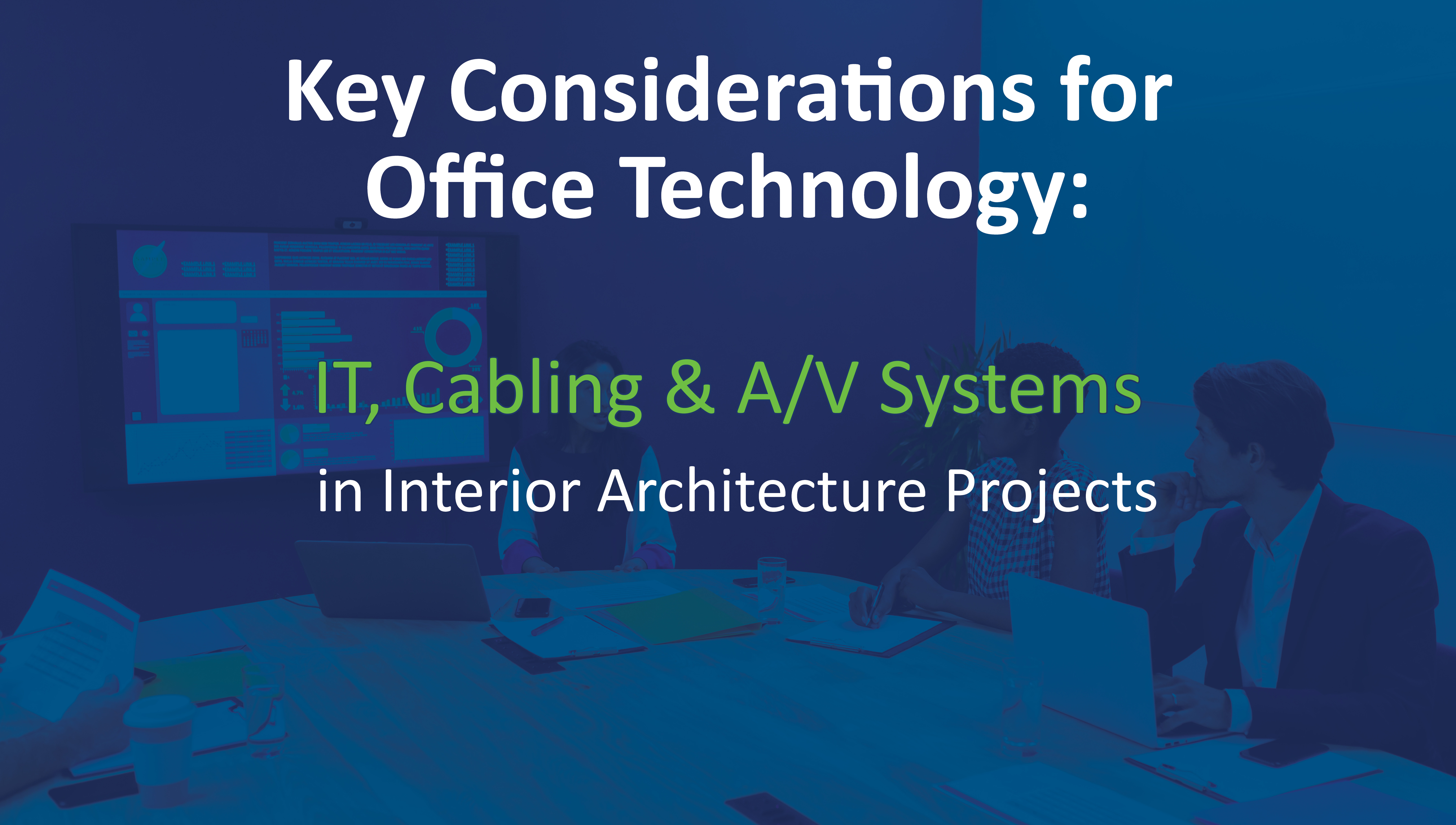Key Considerations for Office Technology: IT, Cabling & A/V Systems in Interior Architecture Projects

When it comes to designing an inspiring and functional office, most clients focus on finishes, layout, and aesthetics — all critical elements. But an equally important piece of the puzzle often gets overlooked until it’s too late: your technology infrastructure. That’s where OneVoice Communications, Inc. comes in. From IT cabling to conference room A/V systems and wireless access points, integrating technology requirements early in the design process is essential for delivering a space that performs as beautifully as it looks. Here’s what you need to know to ensure a smooth, successful project— and how OneVoice can help every step of the way. We partner closely with interior architects, general contractors, and end-users to create high-performance spaces that are ready for the future.
1. Start Early: Why Tech Needs to Be in the First Conversation
Technology isn’t just plug-and-play. Structured cabling, data drops, server room layouts, and A/V hardware all need to be coordinated with walls, ceilings, furniture placement, and finishes.
Why early engagement matters:
- Avoids costly change orders
- Prevents construction delays
- Ensures aesthetic integration (no exposed wires or retrofit fixes)
By bringing in OneVoice early, ideally during programming or schematic design, we work hand-in-hand with your design and construction teams to ensure your technology is fully integrated from the start.
2. IT & Data Cabling: The Hidden Backbone
At OneVoice, we treat your structured cabling infrastructure as the foundation of your office. It supports everything from data flow to A/V performance to WiFi reliability. Key questions to ask:
- Where will the server room or IT closet be located?
- What are the video conferencing and A/V needs?
- Where will the network printer and copier be located?
- Should you conduct a WiFi heat map to optimize wireless access points?
- How will cabling run from the LAN closet to each workstation or meeting room?
- Is the infrastructure future-proof for bandwidth increases and system upgrades?
Coordination with MEP engineers is also vital to avoid interference between electrical and low-voltage systems. This is especially important in ceiling-challenged environments.

3. A/V Systems: Function Meets Form
Modern meeting rooms, lobbies, and collaboration spaces often include high-end A/V technology, including digital displays, video conferencing, and integrated audio systems. These require specialized power, mounting, and cabling that should be accounted for in the earliest design phases. OneVoice and the architects should collaborate on:
- Equipment concealment (inside furniture, millwork, or ceiling spaces)
- Coordination with furniture company to ensure the conference room tables have the correct cut-outs and power to support the video conferencing requirements
- Sightlines and acoustics for hybrid meetings
- Lighting that supports camera visibility
- Wall backing for mounted displays or speakers
Sound masking is another consideration in open-plan environments, especially if acoustic privacy is a concern.
4. Timelines & Vendor Coordination
To avoid project delays, technology vendors should be looped in before construction documents are finalized. Here’s a general timeline:
Phase
Programming
Schematic Design
Design Development
Construction Documents
Construction
Action
Define tech requirements (number of users, meeting types, network needs)
Space planning with rough locations of tech components
Begin coordination with cabling and AV Partner
Finalize cable routes, power/data locations, equipment specs, Reflective Ceiling Plan
Prewire and install prior to final finishes and furniture delivery. Careful coordination with GC to ensure schedule/ inspections stay on track.
Your general contractor, interior architect, and technology vendors need to communicate frequently to ensure a successful office build.
5. Budgeting for the Full Picture
Many clients assume technology costs are limited to laptops and routers, but professional-grade solutions involve more and require infrastructure to support them. To budget accurately, engage OneVoice early to understand necessary cabling and A/V requirements. This cost will vary depending on the size and complexity of the space. Ensure the plan is tailored to both today’s needs and tomorrow’s growth.


6. Voice & Internet Services: Plan for Lead Times
When the project is nearly complete and it is time to connect your office technology, you want to be prepared. Voice and internet services are often an afterthought, but they can have some of the longest lead times of any technology element in a new office project.
Depending on the voice/internet solution you choose, we may need to run new fiber or copper lines to your suite, or install network interface devices (NIDs) in the building. We have seen lead times vary from 30 – 120 days or more.
OneVoice provides cost-effective voice and internet solutions backed by industry-leading technology. We specialize in creating a flexible customized package of voice, data and other business communications services – without sacrificing personal attention.
Be proactive by:
- Identifying service options for your building early.
- Ordering internet and phone services well in advance
- Planning for any equipment needs such as routers, firewalls, or cloud phone systems
- Coordinating demarcation points and cabling routes with building management
OneVoice can help with all of these items, so let us take the guesswork out of your voice and data services. We strive to create a seamless customer experience that surpasses your expectations and sets us apart from the competition.
Final Thoughts: Design for Performance, Not Just Looks
Many tenants are unaware of the complexity behind the technology that powers their offices. At OneVoice, we believe a well-designed office isn’t just beautiful — it’s intelligent, connected, and ready for what’s next. Our technology planning process ensures your space supports productivity, collaboration, and long-term success.
Incorporating these technology considerations into your project timelines can reduce delays, improve performance, and create an office that is truly future-ready. When thoughtfully coordinated, your technology can enhance employee experience, boost productivity, and future-proof your space.
Ready to get started on the technology side of your office build or relocation? Contact OneVoice Communications to schedule a consultation and put a trusted partner on your project from day one.
